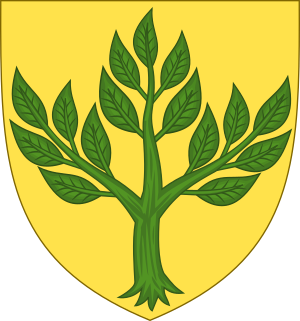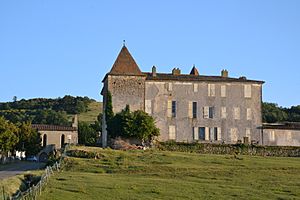Jean d'Aulon facts for kids
Quick facts for kids
Jean d'Aulon
|
|
|---|---|

Jean d'Aulon's coat of arms
|
|
| Born | 1390 |
| Died | 1458 Beaucaire, Gard, France
|
Jean d'Aulon (born 1390, died 1458) was a brave French knight and lord. He is most famous for being a close companion to Jeanne d'Arc. He served her as a soldier, helper, bodyguard, and squire. Jean d'Aulon kept detailed journals. These writings are very important. They help us understand a lot about Jeanne d'Arc's life and adventures.
Contents
Biography
Early Life
Jean d'Aulon was born in 1390. His family was noble and lived in a region of France called Gascony. His personal symbol, or coat of arms, showed an alder plant with three green branches.
A Life in the Military
Serving the King
Jean d'Aulon began his military career around 1410. He first led squires for Queen Yolande d'Anjou. In 1416, he became a captain of royal guards for King Charles VI. He held this job for seven years. After King Charles VI died, Jean became an important advisor to King Charles VII.
Trusted by the King
Between 1425 and 1429, Jean d'Aulon led many different military groups. He was known for his wisdom and loyalty. King Charles VII trusted him greatly. Because of this trust, the King named Jean d'Aulon as Jeanne d'Arc's personal guard in 1429. This happened after Jeanne d'Arc convinced the King to let her lead French troops.
Fighting Alongside Joan of Arc
Jean d'Aulon was with Jeanne d'Arc during the Siege of Orléans. He helped her capture the St. Loup fortress. Jean and other soldiers lived very closely with Jeanne. They traveled and slept on the ground beside her.
He accompanied Jeanne d'Arc to many important places. These included Chinon, Poitiers, Tours, and Blois. Here, she was approved to fight by the King's advisors. Then, they went into battle against the English. They fought in Orléans, Jargeau, Meung-sur-Loire, Beaugency, Patay, and Reims. He was also with her during the Paris and Compiègne.
Capture and Release
During the Siege of Compiègne, Jeanne d'Arc and her small army tried to take the city back. But Duke Philip III and his English allies captured Jeanne d'Arc. Jean d'Aulon and about 200 other soldiers, including Jeanne's brother Pierre, were also captured on May 23, 1430.
The English paid a large sum of money to take Jeanne d'Arc. They brought her to Rouen. There, she was put on trial for serious charges and later burned at the stake. Jean d'Aulon would later speak up strongly in her re-trial in France.
Jean d'Aulon was held prisoner for about two years. He was freed after a ransom was paid. He continued to work for the King. He went on many missions across France for many years. In 1438, he became the King's counsellor. He also managed the King's household. In 1450, he was promoted to the King's chamberlain.
Land and Titles
King Charles VII showed his thanks to Jean d'Aulon. He was grateful for Jean's loyalty and great military skills. The King gave him many titles and properties. In 1428, Jean was known as the lord of Mézerville, Peyrefitte-sur-l'Hers, and Bélesta. By 1438, he was the seneschal (a high-ranking official) of Beaucaire and Nîmes. He was made captain and governor of Castelnaudary in 1445. Nine years later, he became captain and governor of Pierre-Scize near Lyon. The last lands he received were in 1450. These were Caudeval and Peyrepertuse.
Family and Later Life
Jean d'Aulon married twice. His first wife was a daughter of Jean Juvénal des Ursins. After she died, he married Hélène de Mauléon. He had at least two sons, Philippe and Mathieu, and a daughter named Cécile.
Jean d'Aulon died in August 1458 in Beaucaire. After his death, his land of Peyrepertuse was passed to his son Pierre.
Depictions in Media
TV and Film
- Joan of Arc (1948) — Ethan Laidlaw
- Daughters of Destiny (1954) — Robert Dalban
- Joan of Arc, the Power and the Innocence (1989) — Éric Vasberg
- Joan the Maid (1994) — Jean-Pierre Becker
- The Messenger: The Story of Joan of Arc (1999) — Desmond Harrington.
Video Games
A character named Jean appears in the video game Jeanne d'Arc. People debate if this character is based on Jean de Metz or Jean d'Aulon. This character is noble and carries a spear. He and Bertrand de Poulengy join Jeanne d'Arc's cause in Neufchâteau. They do so under orders from the commander of Vaucouleurs.


